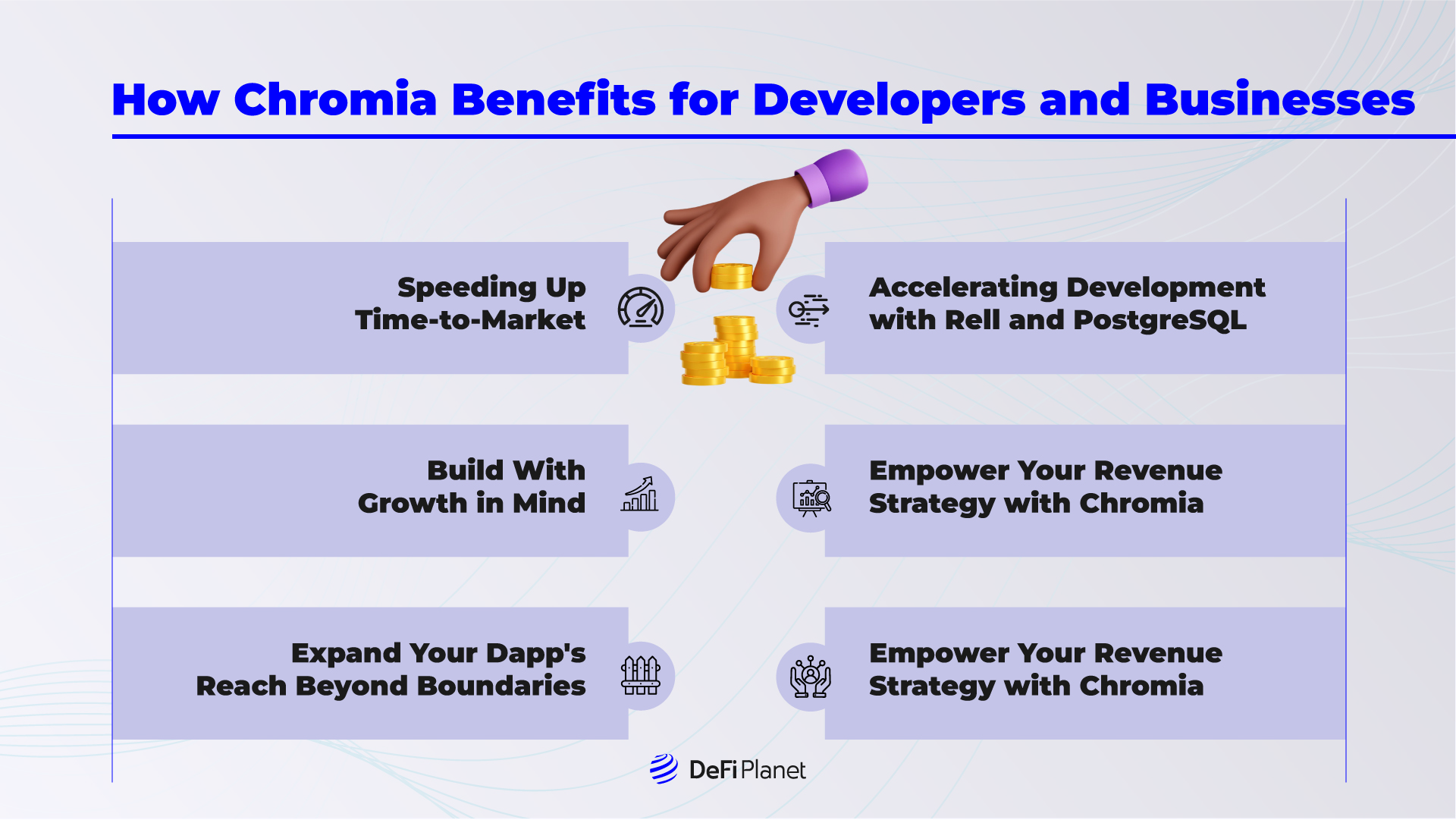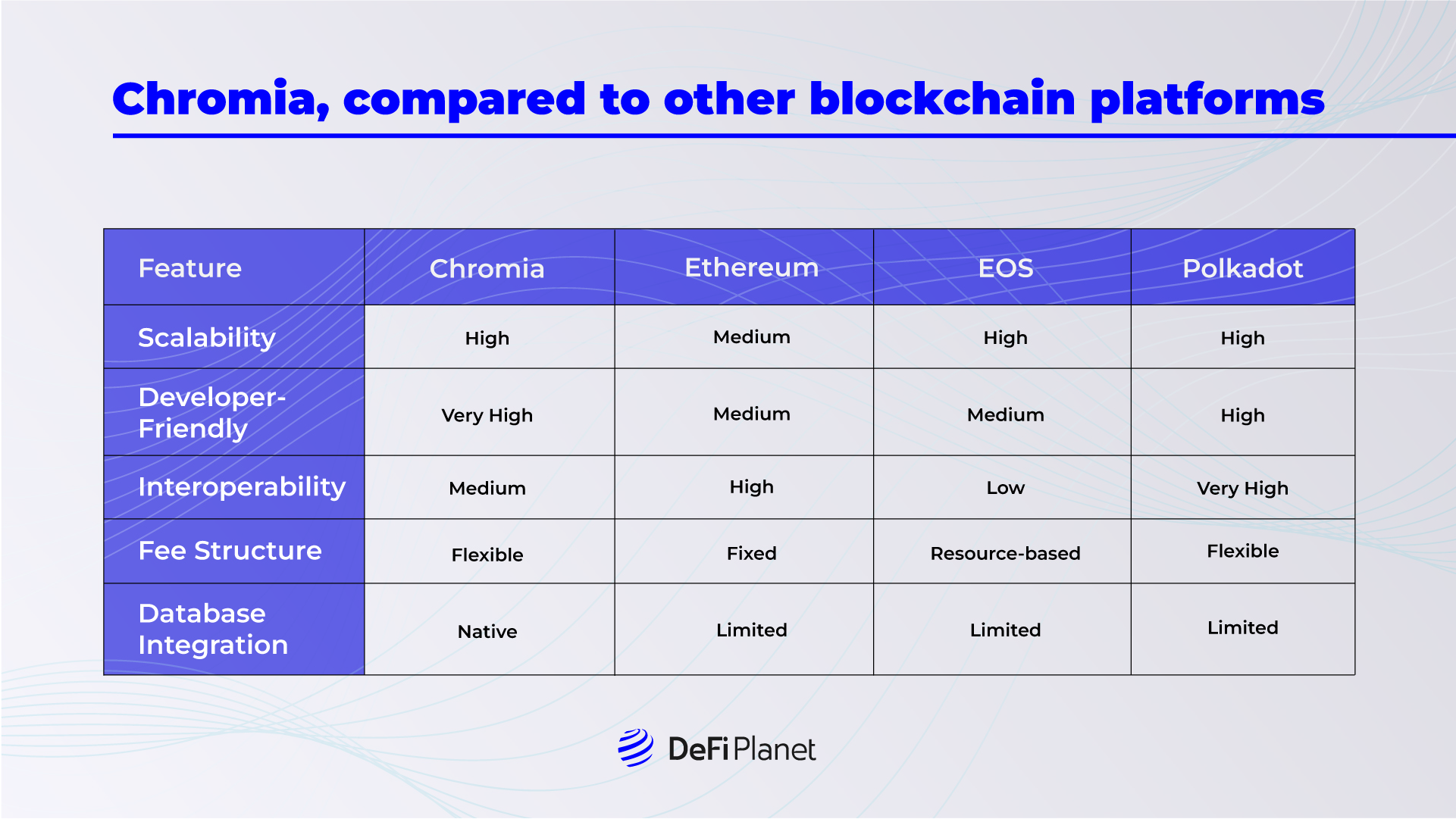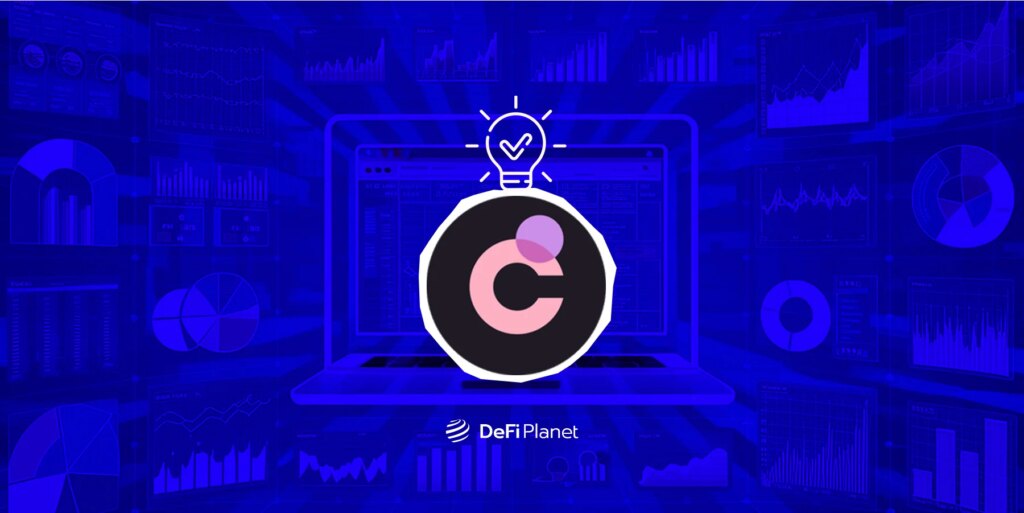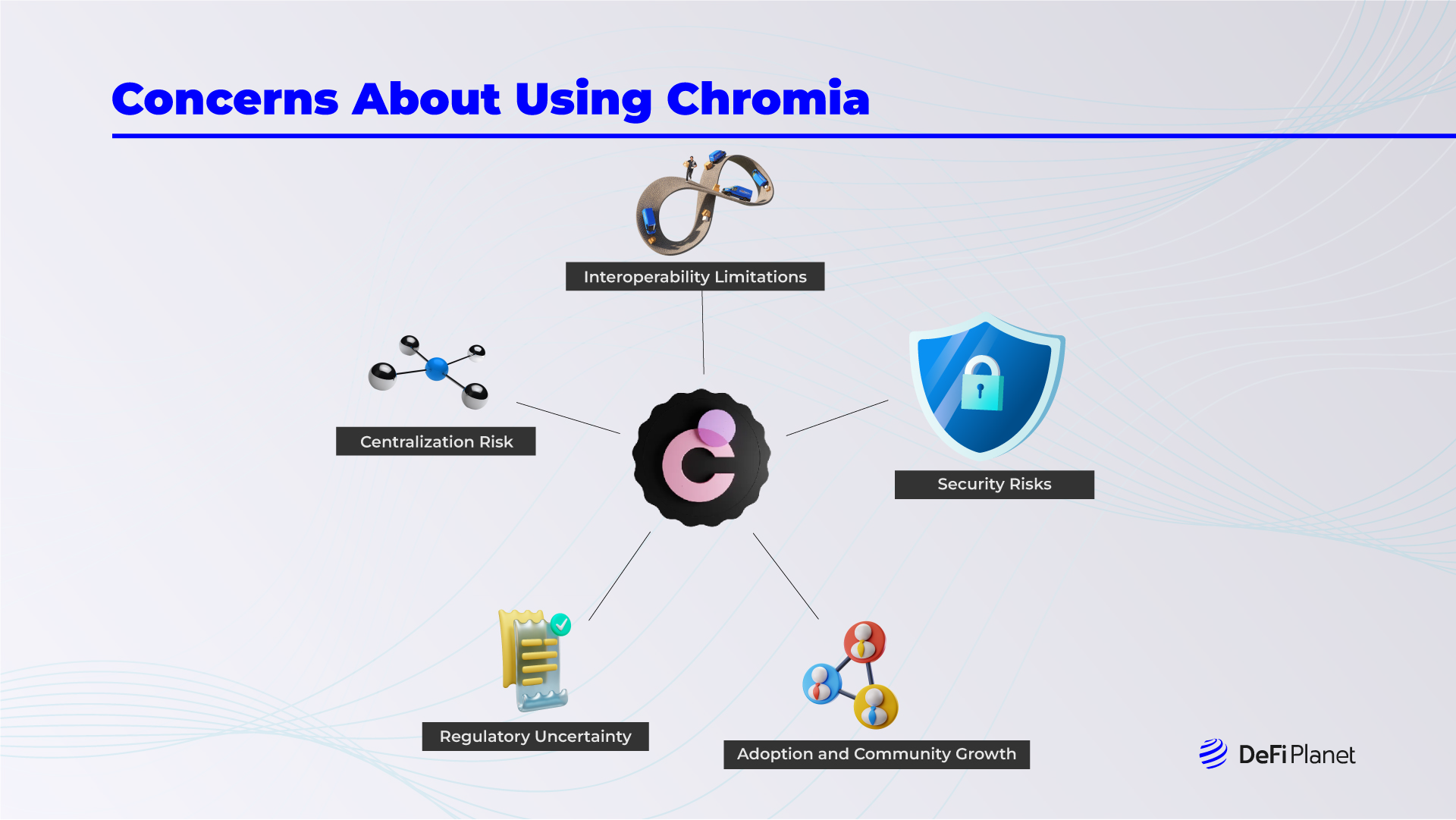With their primary list-format knowledge storage, conventional blockchain networks usually battle to deal with advanced knowledge units and sometimes depend on centralized servers and third-party suppliers. This reliance results in points like poor consumer expertise, excessive charges, irritating developer experiences, and insufficient safety.
Swedish firm, Chromaway, is making an attempt to resolve these points with Chromia, an open-source blockchain community whose MVP Mainnet officially launched on July 16, 2024.
Chromia’s answer is to switch the information storage and administration system by integrating relational databases into blockchain structure. This fashion, the platform allows dApps to scale to tens of millions of customers with out incurring excessive charges or compromising safety and consumer expertise.
How Chromia Works
Chromia combines the relational database method, an easy approach of structuring info in tables, rows, and columns, with blockchain know-how’s immutability and decentralization to create a extra intuitive and highly effective platform. This integration permits for recording structured blockchain knowledge in linked relational tables, enabling direct on-chain knowledge queries, environment friendly read-and-write operations, and real-time knowledge indexing.
In Chromia’s setup, nodes deal with conventional blockchain processes ( transaction processing, block validation, voting, and consensus mechanisms) utilizing a light-weight software program layer whereas sustaining the blockchain ledger. Knowledge is initially written to at least one node, which then distributes it to others. As soon as consensus is achieved, the information is completely logged into the blockchain.
Central to Chromia’s operation is “Postchain”, a system that mixes blockchain safety with superior database capabilities. It’s designed to deal with advanced queries and permits builders to create decentralized apps (dApps) on separate blockchains native to Chromia or exterior to it.
Postchain runs on Kotlin and is constructed to run effectively on the Java Digital Machine (JVM), which is nice for servers and comes with a lot of instruments and libraries. This know-how is essential for Chromia as a result of it helps meet the wants of high-performance dApps. These embody quick transaction confirmations in only one second, dealing with not less than 500 transactions per second per sidechain, and managing as much as 100,000 updates and reads each second.
The platform’s consensus mechanism is an enhanced type of the Byzantine Fault Tolerant (eBFT)mechanism. Since every dApp on Chromia runs on its blockchain, this modified consensus permits the a number of nodes to validate transactions for community safety and reliability.
Chromia organizes nodes into two clusters: the System Cluster and the dApp Cluster. The System Cluster manages important system companies, whereas the dApp Cluster hosts decentralized functions (dApps) with devoted assets. Every dApp operates autonomously on its blockchain, and cluster nodes validate transactions and route them to their respective dApp blockchains.
As well as, Chromia facilitates knowledge switch between the a number of chains in its ecosystem by way of two protocols: ICMF (Interchain Messaging Facility) and ICCF (Interchain Affirmation Facility).
Chromia optimizes dApp growth by leveraging PostgreSQL for knowledge storage and querying and employs Rell (Relational Language) to streamline blockchain growth, decreasing the training curve for builders with database expertise.
The platform additionally contains the Chromia Vault, a pockets software program designed to handle tokens securely and dApps on the blockchain.
The CHR Token
The CHR token is central to the Chromia blockchain, fulfilling numerous roles inside the ecosystem. Initially an ERC-20 token on Ethereum, it has been migrated to Chromia’s native blockchain after its mainnet launch. These are a few of the primary roles it performs:
- Acts as collateral for brand new node installations
- Facilitates dApp deployment and transaction charges
- Operates inside staking and reward techniques for community contributors
- Allows builders to create tokens backed by CHR
How Chromia Advantages The Blockchain Ecosystem
 Although customers of dApps on Chromia will benefit from the platform’s seamless interactions and effectivity, the builders and companies constructed round these functions are the largest beneficiaries for the next causes.
Although customers of dApps on Chromia will benefit from the platform’s seamless interactions and effectivity, the builders and companies constructed round these functions are the largest beneficiaries for the next causes.
Accelerated Improvement of Protocols and dApps
Chromia helps pace up blockchain growth in a approach that permits builders to convey their concepts to market shortly. It achieves this with its user-friendly growth language, Rell, and compatibility with PostgreSQL. This setup permits builders, notably these from net growth backgrounds, to concentrate on their dApp’s options. As an illustration, a sport developer can use Rell language and PostgreSQL to shortly construct an interactive gaming platform, specializing in sport mechanics quite than backend infrastructure.
The platform additionally makes the Improvement of blockchain-based functions accessible to a broader viewers past simply these with in depth blockchain experience. This variation permits creators to simply ship modern blockchain options worldwide, specializing in refining their enterprise logic quite than coping with technical challenges. In consequence, this accelerates the time-to-market for his or her merchandise.
Scalability
Chromia’s structure prioritizes scalability and efficiency. With a concentrate on excessive throughput and environment friendly consensus mechanisms, the platform helps strong and optimum efficiency for many dApps.
A DeFi platform constructed on Chromia can deal with rising transaction volumes with out compromising efficiency, making certain a clean consumer expertise during times of peak utilization.
Customizable Price Constructions
Chromia empowers developers with customizable fee structures tailor-made to their product imaginative and prescient and income objectives, together with subscriptions, microtransactions, and dynamic pricing. This flexibility helps modern income fashions, fostering creativity in how Dapps have interaction financially with customers and nurturing an ecosystem the place new enterprise fashions thrive. As an illustration, a healthcare dApp on Chromia can implement microtransactions to entry medical information securely, making a sustainable income stream whereas providing inexpensive healthcare options to customers.
Interoperability
Chromia facilitates seamless interplay with property and good contracts past its community by way of Ethereum anchoring. This interoperability allows builders to combine Ethereum’s in style NFTs or use numerous tokens as collateral inside Chromia-based functions. For instance, an NFT market on Chromia can provide Ethereum-based NFTs for buying and selling, increasing the vary of digital property out there to customers and enhancing platform utility.
Issues About Utilizing Chromia
There are potential points and considerations that would impression Chromia’s effectiveness and adoption. These are a few of them.
Centralization Danger
Chromia makes use of a relational database system, which critics argue may focus decision-making energy in comparison with absolutely decentralized blockchains. On this setup, completely different nodes could have various roles or privileges, doubtlessly centralizing authority inside particular entities. For instance, if a small variety of entities management most validating nodes on Chromia, it’d elevate worries about centralization affecting how the community operates and evolves.
Interoperability Limitations
Although Chromia is interoperable with Ethereum, there are considerations about its capacity to seamlessly combine with different blockchain ecosystems past Ethereum. As an illustration, if builders wish to join with blockchains apart from Ethereum, the present anchoring methodology won’t assist direct communication or knowledge sharing, limiting the varieties of decentralized functions that Chromia can successfully assist.
Safety Dangers
Regardless of implementing the eBFT consensus methodology and different safety measures, Chromia faces frequent dangers seen in blockchain platforms. These embody vulnerabilities in good contracts, potential exploits, and the specter of malicious assaults. For instance, vulnerabilities in good contracts deployed on Chromia may result in monetary losses or disruptions within the dApps, impacting consumer belief and the platform’s reliability.
Adoption and Neighborhood Development
Chromia’s success will depend on its capacity to draw and retain builders and customers to construct and use dApps on the platform. There needs to be a deliberate effort to domesticate a thriving neighborhood able to innovating and sustaining various functions that might occur because of the ecosystem being easy sufficient to draw builders and customers.
Regulatory Uncertainty
Like different blockchain platforms, Chromia should navigate evolving regulatory environments worldwide. Uncertainty relating to cryptocurrency laws, good contracts, and knowledge privateness may impression its operations and adoption.
Balancing compliance with regulatory necessities whereas preserving decentralization and consumer privateness poses vital challenges. As an illustration, adjustments in regulatory frameworks would possibly have an effect on how Chromia interacts with monetary establishments or handles consumer knowledge. The platform may have changes in its structure or operational practices to stay compliant and operational.
In Conclusion
Chromia represents a big step ahead in blockchain know-how, providing a novel answer to conventional blockchains’ advanced knowledge administration challenges.
The potential functions of Chromia span numerous sectors, together with finance, gaming, actual property, insurance coverage, and healthcare. Its capacity to deal with advanced knowledge constructions effectively, coupled with its scalability and customizable price constructions, positions it as a robust contender within the blockchain area.
The success of Chromia will finally depend upon its capacity to ship on its guarantees of improved efficiency, ease of Improvement, and scalability, whereas additionally fostering a sturdy ecosystem of builders and customers.
Because the blockchain trade continues to evolve, Chromia’s modern method could properly show to be a pivotal growth within the quest for extra environment friendly, scalable, and user-friendly blockchain options.
Disclaimer: This text is meant solely for informational functions and shouldn’t be thought-about buying and selling or funding recommendation. Nothing herein must be construed as monetary, authorized, or tax recommendation. Buying and selling or investing in cryptocurrencies carries a substantial danger of monetary loss. All the time conduct due diligence.
If you want to learn extra articles (information reviews, market analyses) like this, go to DeFi Planet and comply with us on Twitter, LinkedIn, Facebook, Instagram, and CoinMarketCap Neighborhood.
“Take management of your crypto portfolio with MARKETS PRO, DeFi Planet’s suite of analytics instruments.”


